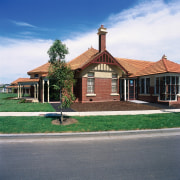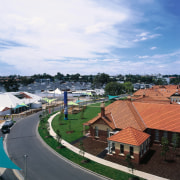Changing rooms
The Commonwealth Games Athletes' Village in Melbourne has been designed to be easily adapted for a variety of future uses
Providing temporary accommodation for 4,500 athletes and 1,500 officials from 71 nations for 25 days during a major sporting event such as the Melbourne 2006 Commonwealth Games is no mean feat. However, what would happen to the facility after the Games are over was also an important part of the design brief.
Architects Michael Bialek and Bob Sinclair of BLP+SJB have worked with the Victorian Government to design an integrated residential village. Known as Parkville Gardens after Parkville, the Melbourne suburb in which it is located, the development incorporates 155 detached houses, 32 studios, 25 townhouses, approximately 105 apartments and 115 temporary accommodation buildings. Dining halls, a training area, religious facilities, a medical centre, an internet cafe and entertainment areas have all been provided within the village.
Eleven heritage buildings, once the Royal Park Psychiatric Hospital, give a focal point to the Village. These distinctive Queen Anne pavilion buildings, built between 1906 and 1937, have been restored, upgraded and converted by architect Allen Lovell into apartments. To help preserve a sense of their history, the original pressed metal ceilings and feature plaster works have, when possible, been retained. Where these features have needed replacement, the work has replicated the original designs.
Around this heritage precinct are a new apartment block and 14 townhouses, all designed to be sympathetic to the old hospital buildings. The original intention for this part of the development was to provide accommodation for more than 550 athletes. Other precincts each with their own palette of colours and materials are designed by the architects to make reference to various inner Melbourne suburbs.
Initially, both the existing and new buildings and facilities were designed and configured to accommodate the needs of the athletes and officials. After the Games, however, the buildings are being refurbished and converted into a permanent residential development.
Additional houses and apartments are being built in stages, with the project due to be completed by 2015. The new community will comprise approximately 1,000 households, made up of a mix of 100 social housing dwellings, a 100-bed aged care facility, a childcare centre, a community facility and a corner shop. Other houses and apartments will be available for public sale.
As part of the environmentally-friendly design, every house has a six-star energy rating, achieved with features such as double-glazing, gas-boosted solar hot water, insulation, intelligent light systems and rainwater storage tanks. Most homes have a northerly focus with interior living spaces opening onto sunny, north-facing courtyards.
More than 1,000 mature native trees will be planted throughout the Gardens. A five-hectare wetland in Royal Park will provide a habitat for native flora and fauna, while capturing and treating storm-water runoff.
Story by: Trendsideas
Home kitchen bathroom commercial design








